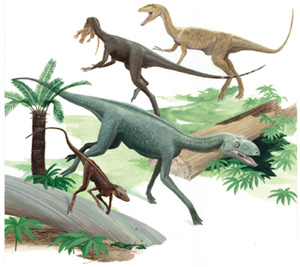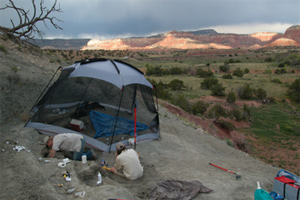Dinosaurs’ rise to dominance was a gradual
Dinosaurs’ rise to dominance was a gradual
mongabay.com
July 19, 2007
Dinosaurs’ rise to dominance was a gradual rather than sudden, suggests new research published in Science.
 This scene depicts four dinosaurs and dinosaur precursors from the Hayden Quarry of northern New Mexico. The coexistence during the Late Triassic of the dinosaur precursors Dromomeron romeri (lower left) and a Silesaurus-like animal (bottom center), and the dinosaurs Chindesaurus bryansmalli (top center, with crocodylomorph in its mouth) and a coelophysoid theropod (upper right), indicates that the rise of dinosaurs was prolonged rather than sudden. Artwork by Donna Braginetz. [Image © Science]  Excavating as an afternoon monsoon thunderstorm sweeps across nearby cliffs. [Image © Science] |
Describing a new collection of fossils from New Mexico, a team of paleontologists from the University of California, Berkeley, the American Museum of Natural History and The Field Museum argue that dinosaurs and their predecessors, dinosaur-like reptiles called the “dinosauromorphs”, coexisted for about 15 to 20 million years toward the end of the Triassic period. According to the researchers, the results challenge the “lucky break” theory which postulated that dinosaurs replaced dinosauromorphs relatively quickly by out competing them for resources are moving into their ecological niche after some sort of extinction event depleted their numbers.
“Up to now, paleontologists have thought that dinosaur precursors disappeared long before the dinosaurs appeared, that their ancestors probably were out-competed and replaced by dinosaurs and didn’t survive,” said co-author Kevin Padian, professor of integrative biology at University of California at Berkeley and a curator in the campus’s Museum of Paleontology. “Now, the evidence shows that they may have coexisted for 15 or 20 million years or more.”
“Finding dinosaur precursors, or basal dinosauromorphs, together with dinosaurs tells us something about the pace of changeover,” said lead author Randall Irmis, a graduate students at UC Berkeley. “If there was any competition between the precursors and dinosaurs, then it was a very prolonged competition.”
The New Mexican fossils include remains from a number of species, “including carnivorous theropods (the group to which T. rex belongs), early dinosauromorphs including a newly identified species called Dromomeron romeri, and other fishes, amphibians and crocodile-relatives,” according to a statement from Science.
CITATION: “A Late Triassic Dinosauromorph Assemblage from New Mexico and the Rise of Dinosaurs,” by R.B. Irmis and K. Padian at University of California, Berkeley in Berkeley, CA; S.J. Nesbitt at Lamont-Doherty Earth Observatory in Palisades, NY; S.J. Nesbitt at Columbia University in Palisades, NY; S.J. Nesbitt and A.H. Turner at American Museum of Natural History in New York, NY; N.D. Smith at University of Chicago in Chicago, IL; N.D. Smith at Field Museum of Natural History in Chicago, IL; D. Woody at University of Colorado in Boulder, CO; A. Downs at Ruth Hall Museum of Paleontology in Abiquiu, NM. Science 20 Juy 2007.